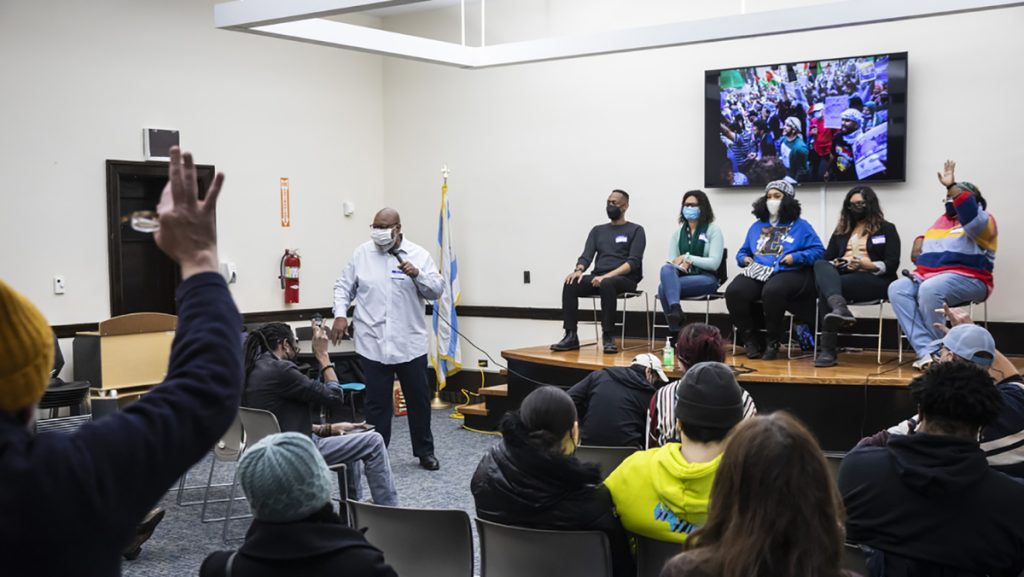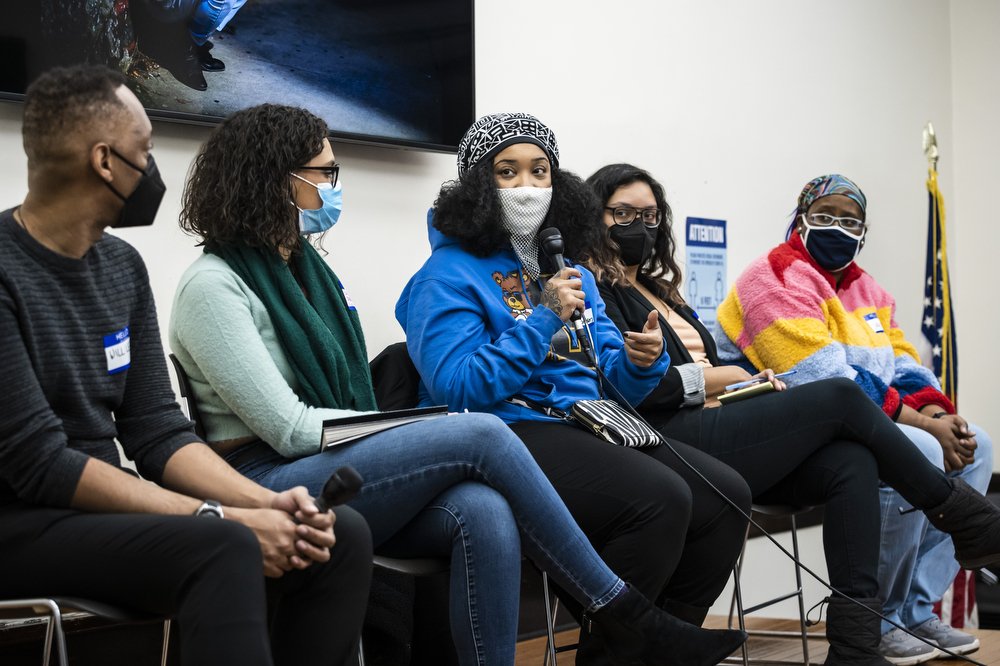
Dr. Marcus Robinson, former executive director of Collaboraction, far left, starts off the Covering Your Community conversation with panelists William “Will” Lee, Cheyanne M. Daniels, Tonika Johnson, Stephanie Casanova and Darcel Rockett, Thursday, Jan. 27, 2022, in Chicago. Photo: Ashlee Rezin
A successful event builds on the basics
The best teacher for future community conversations? The last event
The Covering Your Community project continues with planning for a sequel to our Englewood conversation in January. For that event, we didn’t have a particular topic of conversation other than the goals of transparency and media literacy, receiving criticism, feedback and story ideas, and to forge new relationships with community members. The conversation naturally gravitated toward how Chicago news media can perpetuate the idea of “bad neighborhoods” when it comes to covering crime, especially gun violence, and this only perpetuates disinvestment. A major part of the discussion involved talking about alternative ways to cover violence that involve historical context, humanity and avoiding stereotypes, as well as addressing violence as a symptom of neglected communities, not just something “bad people” do.
“I also believe that hurt people hurt people,” one community member said. “There are no bad people. There are mentally ill people, there are disabled people, and we all have our mental health weaknesses but we have to look at the story and sometimes it goes back multiple generations, because if we went around this room right now and we all shared what’s happened in our family, the trauma and if we’ve benefited by racism and oppression, we would find that we all have had a lot of violence, a lot of alcoholism, a lot of people cheating on their wives, child abuse, a lot of things that actually define who we are. If we don’t present it as part of the context then it just looks like a bad person doing something to a bad person in a bad neighborhood.”
Tonika Johnson was the person to bring up “If it bleeds to leads,” something she said she was taught at Columbia College Chicago when she was a student there and apparently also taught to some of the more seasoned panelists — an example of that old school mindset that we really should be far from at this point.

I am building upon my previous piece to add specifics about how this particular event taught me a lot about organizing and holding a successful community conversation:
Creating a team of people who will help organize and participate in event
- Who of your colleagues will participate? Three of my Chicago Tribune reporter colleagues, William “Will” Lee, Darcel Rockett and Stephanie Casanova, joined the conversation, as well as Cheyanne M. Daniels of the Chicago Sun-Times and the wonderful artist, storyteller and Englewood resident Tonika Johnson. Atavia Reed of Block Club, a very community-specific local publication, had a last minute snafu, but I am hoping to have her back for our sequel event.
- Why is this important? Organizing these events has been a ton of work for me, and I couldn’t have done it without my colleagues, be it from ideas for events, speaking at events, and promotion to discussion about following up within our newsrooms. Planning ahead in December really worked out for me, despite assuming people would be off the grid for holidays, because it gave people a lot of time to put it on their calendars, plan accordingly and prepare for questions. How to choose who to invite? Who lives in this community? Who covers this community? Who covers issues that are of major interest in this community? Who is interested in learning more about this community and forging relationships? Who can people in this community relate to best to facilitate an engaging conversation?
Connecting with established organizations, groups and individuals within the neighborhood while planning events
- There exists a network of people in every community who already have a relationship with their neighbors and will be key to giving advice about the where/when/who of the event planning. For this event, we collaborated with Jay Kelly, a PR person who helped us think about the best event venue and best people to be involved. We also partnered with Collaboraction, a theater company for social change, in inviting community members and promoting the event. I also reached out to Corie Luckett of Englewood Branded who gave me a great deal on some awesome swag to share with event attendees! Englewoods Art Collective and the Resident Association of Greater Englewood (RAGE) also helped us bring people into the conversation.
- As journalists we never want to just parachute into a community, so partnering with prominent community members will help show us as guests looking to make a connection. Partnering with the above people made me feel like we really were guests open to anything and it seemed to be a formula that worked.
Having a focus, talking points and/or topics/issues specific to community members
- We know what we think we did right/wrong, but it is important to listen to community members to learn from their feedback. With a few people driving the conversation somewhat, there was no shortage of questions and comments from the audience, and the panelists had a lot of great things to say. A major quote and takeaway from this event involves addressing racism in media coverage, again from Tonika: “When I was growing up, it was very evident that Black people primarily read the Sun-Times, white people read the Tribune. Specifically suburban white people. For a neighborhood like Englewood and other neighborhoods like it to tolerate this kind of coverage (framing Englewood as a ‘bad’ neighborhood full of crime and violence) — this is the lens that we had to look at it through. Like, of course they would publish this because we know who they’re talking to… And since crime is always covered about our neighborhood, we know we’re not the audience. Because we didn’t tell you we wanted to know that. We know you’re talking to someone else.”
- One of our focuses has been media literacy — explaining the reporting and publication process so people have a better understanding of what goes into telling a story to help them understand how they can be part of that process. I told our audience, “We recently had a couple white guy columnists take a buyout and leave who historically had written some incredibly offensive, racist things about gun violence in various Black and Brown neighborhoods. I think the non-opinion part of our newsroom was getting very frustrated, because if somebody’s writing something racist about Adam Toledo and then we’re still trying to do a story with the family, why should they give us the time of day if we’re also allowing this to go on?”
- One other talking point for our next event will be “What now?” Many people have voiced their opinions and ideas to different Chicago newsrooms, so it’s important to communicate that we as individuals are committed to evolving our own work and doing what we can to make bigger changes in our newsrooms. Our panelists made a promise that our conversation will help start change in our newsrooms. We will be taking our notes back to our editors and colleagues to show what people in different communities really want out of us. If people in positions of power aren’t willing to make changes, we can at the very least retain our relationships with community members and use their feedback in our own work.
Finding a venue where people in the community already gather
- Don’t make people come to you, go to where they are — then people are more likely to attend and participate. We held our last event at a branch of the public library in Englewood, a central place with plenty of space that people in the community were already familiar with. As a bonus, the library doesn’t charge for the space and things like accessibility were not an issue.
Creating promotional methods
- What is the best way to reach a community? Technological considerations for community members who might not have internet access or email; nothing beats going in person and talking directly to people. Flyers were a great way to reach people for our first event and for collaborating with existing community organizations.
What do we as journalists specifically hope to get out of this event? How will we implement change in our newsrooms?
One of the reasons I did this project is because there was a lot of talk in the Tribune newsrooms about, yeah, diversity, and we need to reach a more diverse audience and we need to tell better stories, etc. So we’d have Zoom meetings every month and then like…nothing would happen. So I found this as an opportunity, we can actually meet with the community face to face, get your feedback, which we can take back to our editors which, you know, there’s only so much we can do to sort of incite change but I think this is a good starting point and even if an editor is not going to be on board with something you said, you know, we can make changes in the way we do our daily work. The other thing we’re always talking about is that we need more subscribers…it’s like ok, well then we need to cover these underserved or never served communities or no one is going to be on board with us.”
As I build this toolkit, I welcome feedback from other journalists who plan to use it. What questions and needs do you have? What do you want to know about my process? What would help you dialogue with your community?
The goal of Covering Your Community is for Chicago journalists to have a conversation with members of the community about current and past stories, to be transparent about the publication process and to hear from community members about ways we can improve future stories. We want to establish a regular dialogue with people in our communities and learn what is important to those people. We want to forge new relationships and reinforce current ones.

Comments